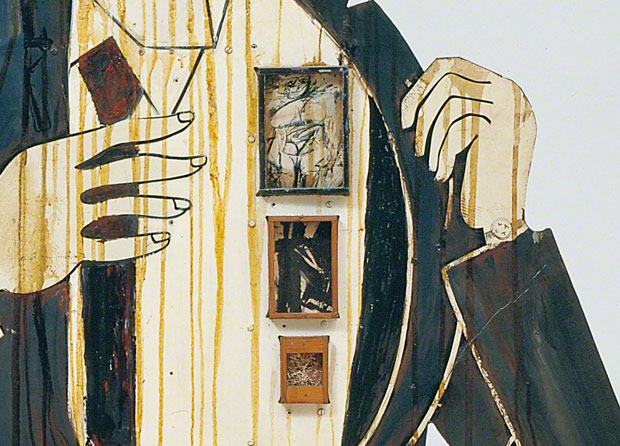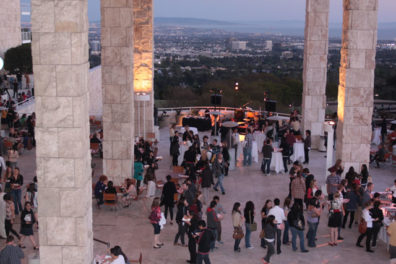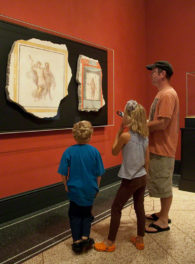
Walter Hopps Hopps Hopps, Edward Kienholz, 1959. Paint and resin on wood, printed color reproductions, ink on paper, vertebrae, telephone parts, candy, dental molds, metal, pencil, and leather. 87 x 42 x 21 in. The Menil Collection, Houston, Gift of Lannan Foundation. © Nancy Reddin Kienholz. Photo: Susan Einstein
Sometimes, only a friend will tell you what they really think. Take the case of artist Ed Kienholz and curator Walter Hopps. Kienholz’s over-life-size assemblage portrait of his friend, Walter Hopps Hopps Hopps—the inspiration for our collage meet-up this Saturday—is both homage and sly critique.
Created from a modified Bardahl motor oil store display, Hopps is portrayed in his trademark sober black suit, skinny tie, and horn-rimmed glasses.
Holding open his jacket lapel, Hopps offers the viewer three miniature paintings by Willem de Kooning, Franz Kline, and Jackson Pollock—New York artists associated with the Abstract Expressionism movement that was so fashionable at the time.
Hopps also wears a wristwatch with the words “LATE” painted across the face. Hopps was known for his chronic lateness, and his colleagues at the Corcoran Gallery of Art in Washington, D.C., once created buttons that read, “walter hopps will be here in 20 minutes.”

There’s more on the reverse side of the sculpture, where several small compartments open to reveal handwritten notes. On a slip of paper near the head is a long list labeled, “Major Artists I Want to Show,” featuring puns on the names of big-name New York artists like “Jackson Potluck,” “Franz Climb,” “Willem de Conning,” and “Robert Nothingwell.”
Other compartments are labeled “Important People w/influence or money” and “Competitors and Other Un-informed Types.” Kienholz used these notes to playfully point out Hopps’s highly calculated ambitions.

Kienholz was one of several artists working in Los Angeles in the ‘50s, ‘60s, and ‘70s who embraced collage and assemblage, techniques of making art from fragments and found materials first developed by Cubists, Futurists, and Dadaists. Only two years after Walter Hopps Hopps Hopps was created, work by Kienholz and fellow L.A. artist George Herms would be included in the 1961 exhibition “The Art of Assemblage” at the Museum of Modern Art in New York—the exhibition that gave this art form its name.
Friends since the mid-1950s, Hopps and Kienholz shared an innate ability to create something from nothing. As a budding curator, for example, Hopps organized a one-day exhibition called Action in 1955, situated on the carousel at the Santa Monica Pier. Kienholz was equally resourceful and inventive, and was known to trade, barter, and find sculpture materials from junkyards, second-hand shops, and cast-off items found on the side of the road.
These shared traits would lead Kienholz and Hopps to come together to open the Ferus Gallery in 1957. Legend has it that they drafted their first contract on a wrapper from Tail-o-the Pup Hotdogs. While most of the neighboring galleries on La Cienega Boulevard catered to the art trends of New York or Europe, Ferus was one of the only local spaces to show the work Los Angeles and San Francisco artists.
In the early ‘60s, this investment in local artists changed when new partner Irving Blum joined the gallery, and eventually bought out Kienholz’s share. In fact, about a year after Walter Hopps Hopps Hopps was made, Ferus mounted an exhibition called 14 New York Artists, which included works by the very artists named on Kienholz’s humorous art world roll-call.
Hopps got back at Kienholz, though: he broke into the artist’s studio to steal his sculpture The Illegal Operation, which the artist was set to destroy. Tongue-in-cheek mockery, thievery when needed—the two were true friends, and remained so till the end.
Come meet this witty portrait of Walter Hopps in person: join a Masterpiece of the Week gallery talk about it by my colleague Audrey Chan this Saturday at 4:00 p.m., followed by drop-in collage making in the Museum Courtyard.




Comments on this post are now closed.
Trackbacks/Pingbacks